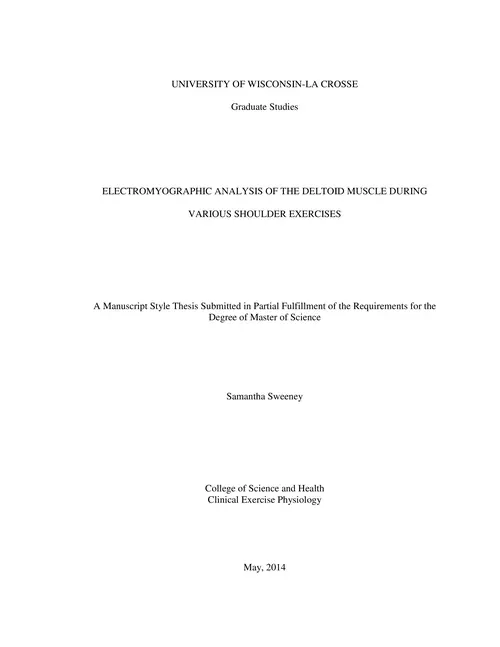
Sweeney_Samantha_Thesis.pdf
Examples of Exercises for Designing a Weight Training Program. Bent-Over Dumbbell Rear Delt Raise. Major Muscle Group: Deltoids.
adsPart of the document
UNIVERSITY OF WISCONSIN-LA CROSSE
Graduate Studies
ELECTROMYOGRAPHIC ANALYSIS OF THE DELTOID MUSCLE DURING
VARIOUS SHOULDER EXERCISES
A Manuscript Style Thesis Submitted in Partial Fulfillment of the Requirements for the
Degree of Master of Science
Samantha Sweeney
College of Science and Health
Clinical Exercise Physiology
May, 2014
ABSTRACT
Sweeney, S.P. Electromyographic analysis of the deltoid muscle during various shoulder
exercises. MS in Clinical Exercise Physiology, December 2014, 46pp. (J. Porcari)
The purpose of this study was to determine which exercise activates the deltoid muscle to
the greatest degree using electromyographic (EMG) analysis. Sixteen experienced male
lifters completed five repetitions of the following exercises using 70% of 1 RM, body
weight, or a rope for resistance: dumbbell (DB) shoulder press, DB front raise, bent arm
lateral raise, seated rear lateral raise, cable diagonal raise, push-ups, battling ropes,
barbell upright row, 45 degree incline row, and dips. Surface EMG was recorded and
represented as a percentage of the maximal voluntary contraction. A one-way ANOVA
with repeated measures was used to test for differences in EMG between exercises.
Anterior deltoid analysis showed a significant difference in muscle activation between
the DB shoulder press and the other nine exercises. Middle deltoid analysis showed no
significant difference between the 45 degree incline row and bent arm lateral raise while
all other exercises elicited significantly lower muscle activation. Posterior deltoid
analysis showed no significant difference between the seated rear lateral raise and 45
degree incline row while all other exercises elicited significantly lower muscle activation.
Based on the musculature of the deltoid and the findings of this study, a variety of
exercises are needed to effectively train the deltoid. Further research investigating
shoulder exercises not tested in this study is still needed.
First and foremost I would like to thank my loving parents who have always been
there for me. I very much appreciate your constant belief in me and occasional tough
love. I would never have dreamed of accomplishing this feat nor be where I am without
you! Morgan and I could not ask for better parents.
I would like to express my sincere gratitude to the wonderful CEP staff at the
University of Wisconsin - La Crosse. The CEP program is what it is because of the
countless hours you dedicate to the program and your students. One could not ask for
better role models. I am also forever grateful for the LEHP participants who have share
with me their life lessons and bright smiles. You truly touch lives every year!
A big thank you to John Porcari, Atilla Kovaks, Clayton Camic, and Carl Foster
for all of your time, patience, and guidance throughout this thesis process! The research
would not have gone as smoothly without your endless areas of expertise and willingness
to help. I feel honored to have had the opportunity to work with you all.
I would not have made it through this very stressful and very fun year without my
classmates and now forever friends. I will never forget the ups and the downs we have
shared this past year. You will all do great things!
Lastly, a special thanks to the Rank family for their positive support and always
making me feel welcome in their home.


